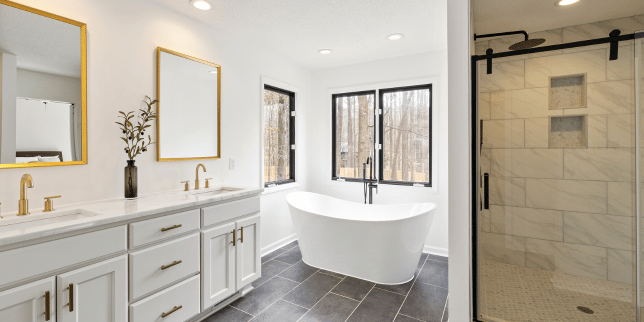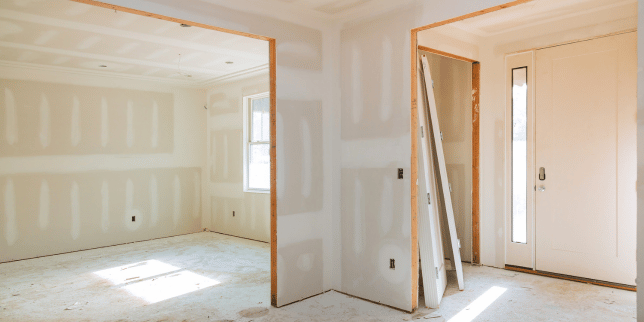
Are you a homeowner with a vision to transform your living space into a dream home? Ready to tackle that renovation project you've been dreaming about for years?
Perhaps you're excited about the idea of a do-it-yourself (DIY) remodel, but you're not quite sure where to start or what it truly takes to accomplish such a venture. Embarking on a DIY remodel can be thrilling and daunting, especially if you're new to home improvement.
So, you’re probably wondering, “What tools do I need for my DIY remodel? How can I ensure my remodel is safe?”
At Custom Built, we understand the excitement and challenges of a DIY remodel. With over 15 years of experience in the remodeling industry, we've witnessed the transformational power of well-executed DIY projects and strive to help homeowners through the process via valuable industry secrets.
From small upgrades to full-scale renovations, we've guided countless homeowners through their remodeling journeys. We're here to share our expertise and guide you toward a successful DIY remodel.
In this article, we will walk you through the essential factors and considerations required to accomplish a DIY remodel with confidence:
1. Define Your Project Scope for Accurate Planning

Before embarking on any DIY remodel, it's crucial to define your project scope clearly. Start by determining which areas of your home you want to remodel and what changes you wish to make.
Whether you're updating the kitchen, renovating the bathroom, or giving your outdoor space a facelift, having a well-defined scope will help you stay focused and organized.
To-Do:
- Create a list of specific remodeling goals and prioritize them based on importance.
- Assess your budget and determine how much you can comfortably allocate to each project.
- Take note of potential challenges or limitations during the remodel, and familiarize yourself with Michigan building regulations and codes.
2. Set a Realistic Budget for Precise Spending

Budgeting is a fundamental aspect of any DIY remodel. Having a clear and realistic budget in place will guide your decisions and prevent overspending.
Have you ever helped your child with a school project and realized the volcano set at the store costs three times more than you thought? From remodeling your home to fixing your car, you must plan your budget for unforeseen expenses.
Consider all aspects of the project, including materials (estimated amount and damaged), tools, labor, and unexpected costs that may arise during the process. Despite all these factors, you should still expect your DIY budget to end up 20%-100% more than your initial estimate to accommodate additional material costs.
Here’s a sample budget you can expect from your DIY home remodeling project:
1. Materials and Supplies:
- Paint: $50 - $150
- Cabinets: $200 - $500 each
- Tiles: $1 - $5 per square foot
- Flooring: $2 - $5 per square foot
- Adhesives and sealants: $20 - $50
- Countertops: $30 - $100 per square foot
- Lumber and building materials: $200 - $500
- Fixtures (lights, faucets, etc.): $50 - $200 each
- Hardware (handles, knobs, etc.): $2 - $10 each
2. Tools and Equipment:
- Safety gear (goggles, gloves, masks, etc.): $20 - $50
- Measuring tools (tape measure, level, etc.): $10 - $30
- Power tools (drill, saw, sander, etc.): $100 - $300 each
- Hand tools (hammers, screwdrivers, etc.): $20 - $50 each
3. Permits and Fees:
- Building permits: $50 - $200
- Inspection fees: $100 - $300
- Any required licenses: Varies
4. Labor and Help:
- If hiring any help for specific tasks: $200 - $500 (per task)
5. Waste Removal:
- Dumpster rental or disposal fees: $100 - $300
6. Transportation:
- Gas and transportation costs for materials and tools: Varies
7. Miscellaneous:
- Incidentals and unexpected costs: $100 - $300
- Contingency fund for unforeseen expenses: 20%-100% of total budget
8. Finishing Touches:
- Decor and finishing items: $50 - $200
To-Do:
- Set aside a contingency fund for unexpected expenses.
- Research the cost of materials and tools needed for your project.
- Obtain multiple quotes for any professional services you might require.
3. Hone Your Skills to Remodel Effectively
A successful DIY remodel requires a certain level of skill and knowledge. While you don't need to be a master craftsman, having a basic understanding of various tasks, such as painting, flooring installation, and cabinet hardware replacement, can save you time, money, and frustration.
Invest time in learning new skills and techniques, and don't shy away from seeking advice or attending workshops to improve your expertise.
To-Do:
- Identify areas where you lack experience and seek resources for learning.
- Consider teaming up with a friend or family member with expertise in a particular area.
- Practice basic skills (painting, installing shelving, installing light fixtures) before starting the actual remodel.
4. Obtain the Right Tools for Your Project

Having the right tools is essential for a successful DIY remodel. Invest in quality tools that will make the job easier and more efficient. Depending on the scope of your project, you may need various tools, including power tools, hand tools, measuring equipment, and safety gear.
For smaller DIY endeavors, such as painting a room or assembling furniture, you'll likely require basic hand tools like a hammer, screwdriver set, measuring tape, and level. These tools are readily available and relatively easy to use, making them suitable for various small-scale household tasks.
However, for larger DIY remodeling projects, such as renovating a kitchen or bathroom, you'll need a more extensive array of tools. Power tools (for professional grade tools, we recommend DeWalt and Milwaukee Tool), such as a cordless drill, circular saw, jigsaw, and reciprocating saw, become essential for cutting and fastening materials.
While we at Custom Built use DeWalt and Milwaukee daily, common brands such as Ryobi and Ridgid will do the job. Whether you’re renting or buying from Home Depot or Lowe’s, remember that drills will differ in quality despite looking the same.
For example, brushed drills last much longer than brushless drills. However, you most likely won’t need a longer-lasting drill, depending on the scope of your DIY project. This is why it’s important to research which tools you’ll need and how intense the build process will be.
To-Do:
- Create a list of the necessary tools and equipment for your remodel.
- Prioritize safety using protective gear, such as goggles, gloves, and dust masks.
- Rent or borrow tools that you'll only use for this particular project to save on costs.
5. Plan for Mid-Project Safety
Safety should be a top priority throughout your DIY remodel. Familiarize yourself with safety guidelines and precautions for the tasks you'll be undertaking. Take the time to set up a safe working environment and ensure adequate ventilation and lighting.
For example, lead and asbestos might be in your Michigan home without your knowledge. These hazardous materials, commonly found in older homes and buildings, pose serious health risks if improperly handled. Lead can be present in paints used before 1978, while asbestos might be in insulation, flooring, and other building materials.
To-Do:
- Keep a first aid kit readily available in case of minor injuries.
- Enlist a friend or family member to help with heavy lifting or tricky tasks.
- Read the instruction manuals of all tools and equipment before using them.
6. Prepare for Potential Obstacles During Your Remodel
It's not uncommon for DIY remodels to encounter unexpected obstacles along the way. Be prepared to adapt and problem-solve as you encounter challenges. A flexible mindset will help you stay focused and motivated, even when things don't go as planned.
To-Do:
- Anticipate potential obstacles and have backup plans in place.
- You’re going to make mistakes. Slow down, measure, and cut/drill again.
- Contact online forums or community groups for advice and support when facing challenges.
7. Make Sustainable Choices that Benefit the Environment
As you embark on your DIY remodel, consider making eco-friendly and sustainable choices. From energy-efficient lighting fixtures to recycled materials, opting for green alternatives can not only benefit the environment but also save you money in the long run.
To-Do:
- Research sustainable building materials and eco-friendly practices.
- Look for Energy Star-rated appliances and fixtures that are energy-efficient.
- Reuse or upcycle existing materials from eco-conscious companies whenever possible (Trex, IceStone, Greenfiber, etc.).
8. Take Your Time While Building
Rome wasn't built in a day, nor will your DIY remodel. Take your time to plan, execute, and complete each task with care and attention to detail. Rushing through the process can lead to costly mistakes and unsatisfactory results.
To-Do:
- Celebrate your progress and accomplishments along the way.
- Don't hesitate to take breaks or step back if you feel overwhelmed.
- Create a realistic timeline for your remodel and set achievable milestones.
Next Steps to Planning Your DIY Remodel
Whether you're a first-time DIY enthusiast or a seasoned renovator, we understand that embarking on a remodeling journey can be exciting and daunting. The desire to create a space that reflects your vision and style while adhering to a budget and timeline may be your primary motivation, but knowing where to start and how to navigate the process can present challenges.
Throughout this article, we've explored the key elements and considerations involved in accomplishing a DIY remodel. From defining your project scope and setting a budget to honing your skills and ensuring safety, we've covered the essential aspects to help you embark on your remodeling journey.
By now, you have a comprehensive understanding of what it takes to tackle a DIY remodel. With the right planning, preparation, and mindset, you can turn your visions into reality and create a home that reflects your personality and style.
At Custom Built, we have a passion for helping homeowners achieve their remodeling goals, whether it's through professional services or empowering you to take on DIY projects. With 15+ years of experience, we're here to support and guide you every step of the way.
For more information on how to plan a home remodel, we recommend the following articles:
Michael brings over 2 decades of building and remodeling experience to his position as the Owner and Visionary of Custom Built. Michael’s passion to make an impact on the home building industry has led him to serve for over ten years at the local and state Home Builders Association, culminating as President of the HBA of Michigan in 2020.
Topics:


























